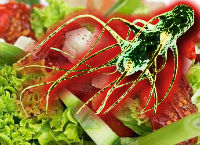Organism Details:
Shape and Size
� �v�a�r�i�a�b�l�e� �i�n� �l�e�n�g�t�h�,� �m�o�s�t�l�y� �3�0�0 ��7�0�0
�¼�m� �l�o�n�g�
�s�u�b�g�l�o�b�o�s�e� �o�r� �i�r�r�e�g�u�l�a�r�l�y� �s�h�a�p�e�d�,
Genome Information
Aspergillus parasiticus is a mold ( GI: 45477378 has a linear DNA of 82081 bp .
Food Source
Meat and Meat Products
Milk and Milk Products
Soft Cheeses
Hard Cheeses
Fish and Fish Products
Fruits and Vegetables
Water and Beverages
Delicatessen
Cereals
Spices
Honey
Eggs
Pathological Factor
A. parasiticus produces aflatoxins B -1, B-2 , G-1 and G 2 but not cyclopiazonic acid and almost all the strains are Toxigenic. The which can occur in naturally contaminated agricultural commodities
Disease
It causes severe gastrointestinal and neurological disorders along with degenerative changes and necrosis in the digestive tract, liver, kidney and heart.
|








